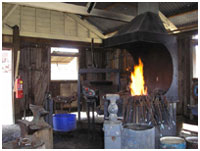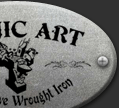

History of Blacksmithing
It boggles my mind that many people associate blacksmithing only with horseshoeing. True, one who shoes horses is a Blacksmith, but he is called a Farrier. His is only one small division of the trade. That’s like saying that the orchestra leader knows only one instrument. Blacksmithing encompasses artists and craftsmen, each of whom may have a specialty. Just as the Maestro must know all instruments to create a harmonic symphony, the Blacksmith can orchestrate the creation of a variety of forms from his forge. He may create fences, gates, banisters, sculptures, candleholders, furniture, light fixtures, liturgical items, locks, knives, and infinite variations on the themes.
Metal Forging

Since the beginning of the twentieth century, references have relegated the ironworker to a more poetic than productive position. The image of the muscular blacksmith pounding on his anvil, the ringing of the hammer blow, and the smell of the forge became a romanticized vision of the past. Objects once carefully and lovingly wrought by the smith were mass-produced of cast iron by industry which could make them cheaper and faster. There is incredible activity and interest in working iron by individual metalworkers and sculptors.
Throughout the country, blacksmiths working at forges or with other heat sources are shaping hot iron into myriad creative forms that are functional and beautiful. They are a new breed of blacksmith, men and women, who are rediscovering the inherent beauty and the malleability of the heated black metal as a medium for contemporary artistic statements.
The ironworks are rediscovering what generations of smiths knew long ago – that iron has remarkable properties. It is a metal which can be drawn out, formed, machined, cast, laminated, hammered, inlaid, etched, punched, split, rolled, bent, chased, spun, welded, riveted, collared, and more. The plasticity of hot iron invites spontaneity … a kind of direct action among man, fire, hammer and metal.
The Artist Blacksmith: Past and Present

Future art historians may dub the last quarter of the Twentieth Century, “The New Age of Iron”. During those years metal workers, discovering that iron and steel had untapped potential, unleashed an uncanny fervor that gave birth to a new muse.
Before then, blacksmiths in early America were responsible for making mostly functional items. They made and repaired farm equipment, provided nails for builders, created weapons, and even pounded steel into armor. Large shops fashioned anchors, anvils, furnaces, and strapped together large pieces of wood. Many smiths in Colonials days had to make their own iron from local ore and fuel supplies. The ore used was usually bog ore, a ferrous hydrated iron oxide, and the fuel was charcoal.
Some decorate work for fences and gate tops was made mainly for security purposes. Items for kitchens and fireplaces were more functional than decorative, though their shapes and construction were infinitely varied. Many specialists existed. Armorers made items for cavalry units from simple helmets to body armor. Farriers were specialists who shoed horses. Cutlers made knives, swords, and scissors. The blacksmith of yore had to be lever in working with different grades or iron, improvising as he created, and producing a high quality product.
The European blacksmith fared somewhat better though he was usually anonymous and copied or followed plans that he was given. Gates, fences, grilles, railings, and doors were needed. The designs were usually beautiful and ornate decorate ironwork of the Renaissance and Gothic periods that replicated the linear drawings from early illuminated anuscripts. These same designs with variations and a few additions continued during the Baroque, Rococo, and Neo-Classical periods in Spain, Italy, Germany and France.
Throughout these years, scrolls and straight bars dominated, some heavier, some lighter than others. In time arabesque shapes, flowers, fruit, birds and animals appeared. From the 16th Century to the very end of the 19th Century the art form was relatively stagnant, and no significant changes were recorded for architecture, sculpture or furnishings. These styles still prevail in many countries.
Considering that iron has been shaped by man to fulfill his needs since about 1200BC through out present industrial society, what possibly could be new? Plenty.

